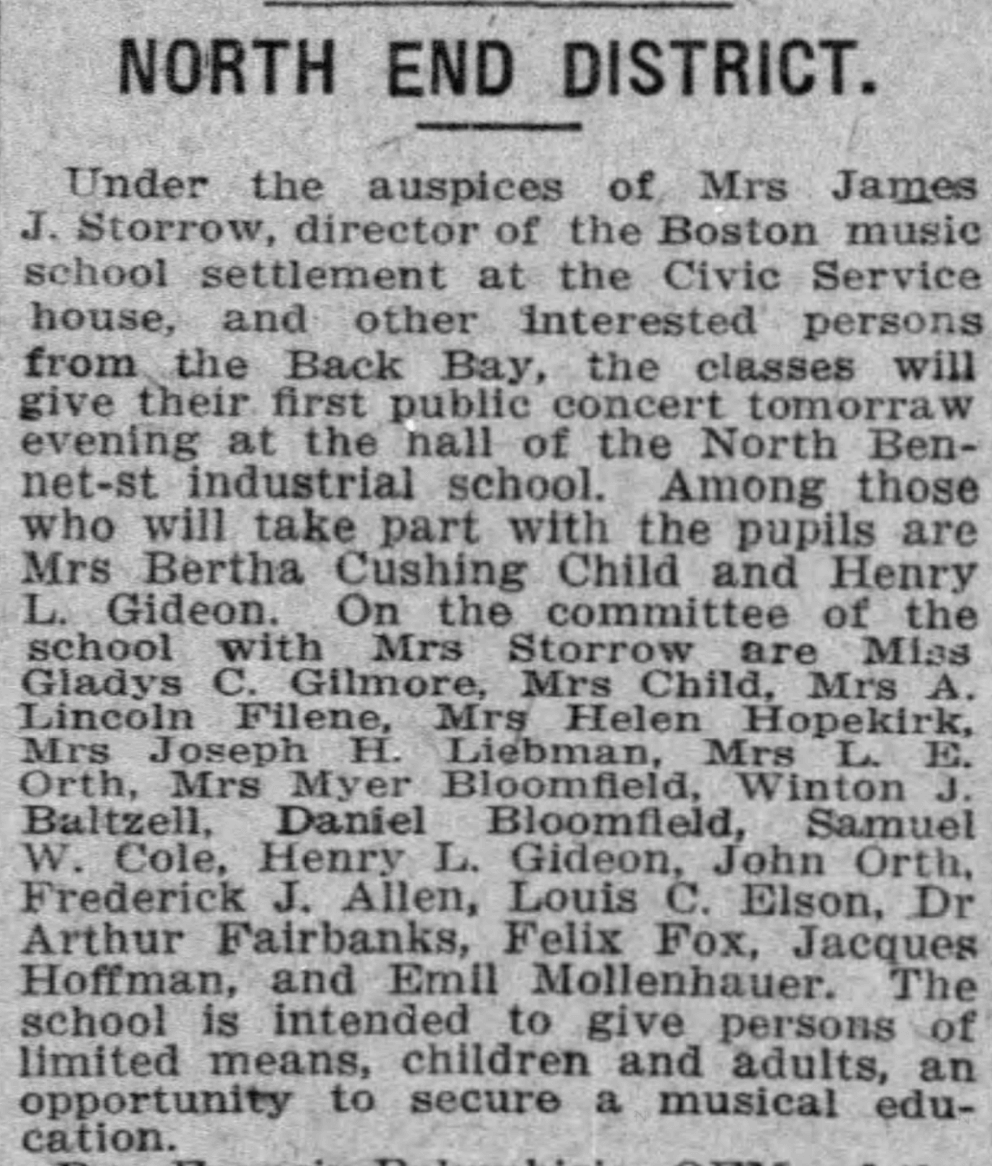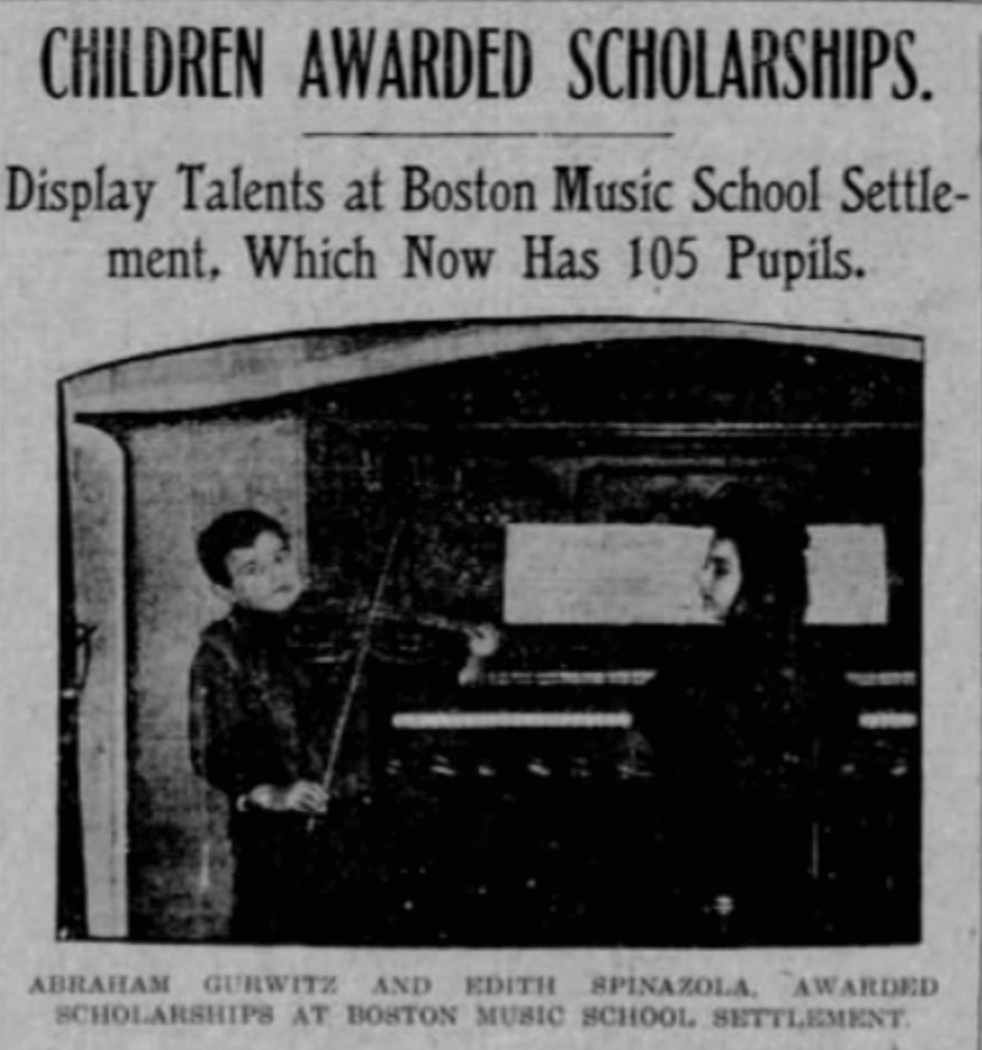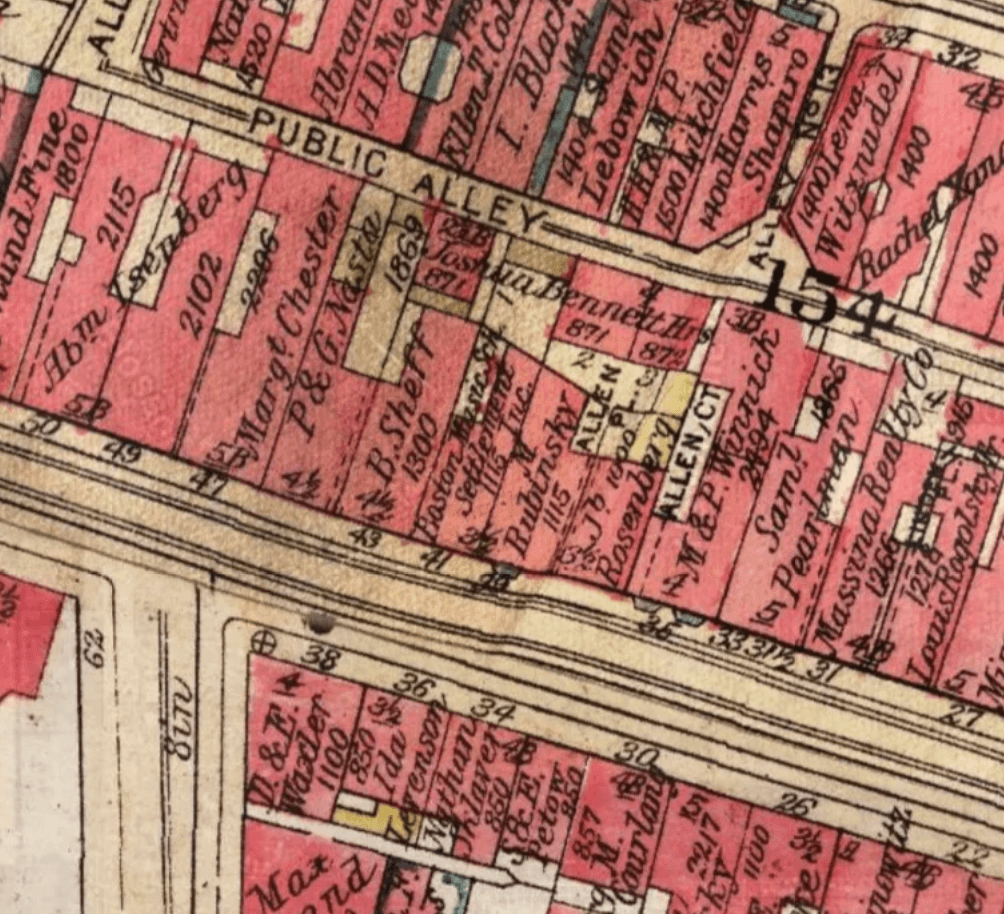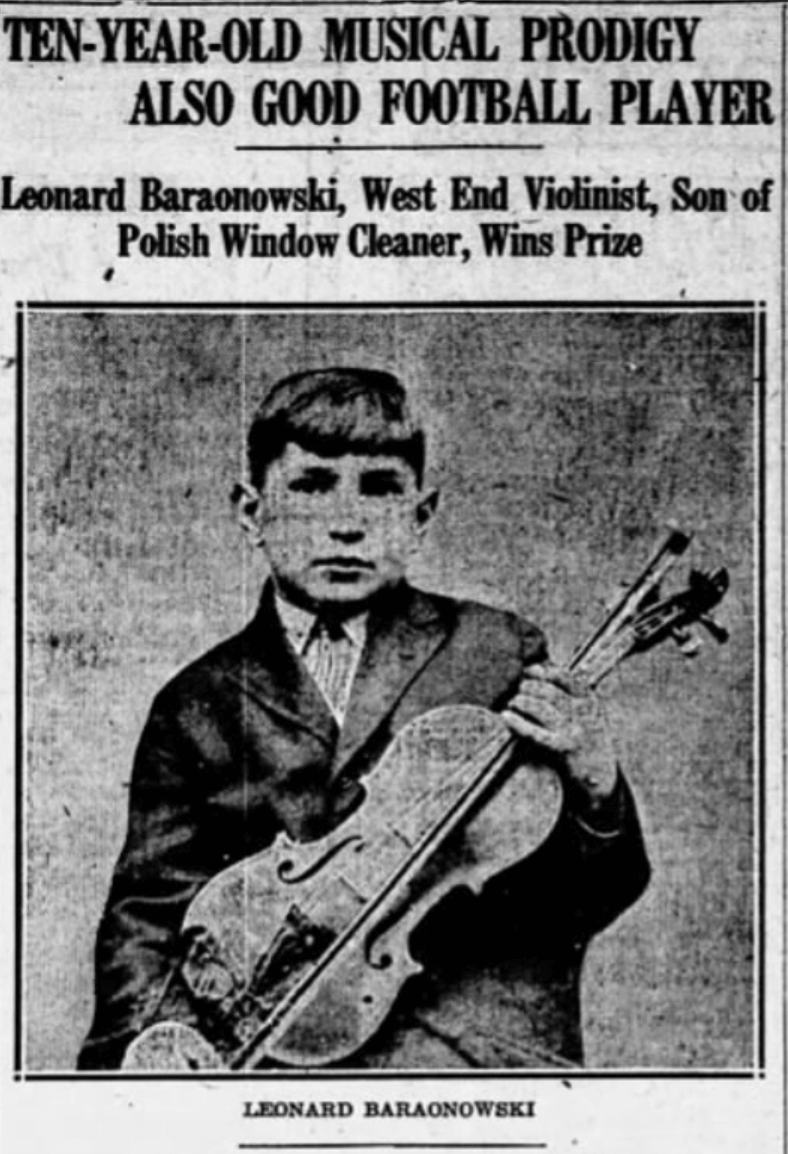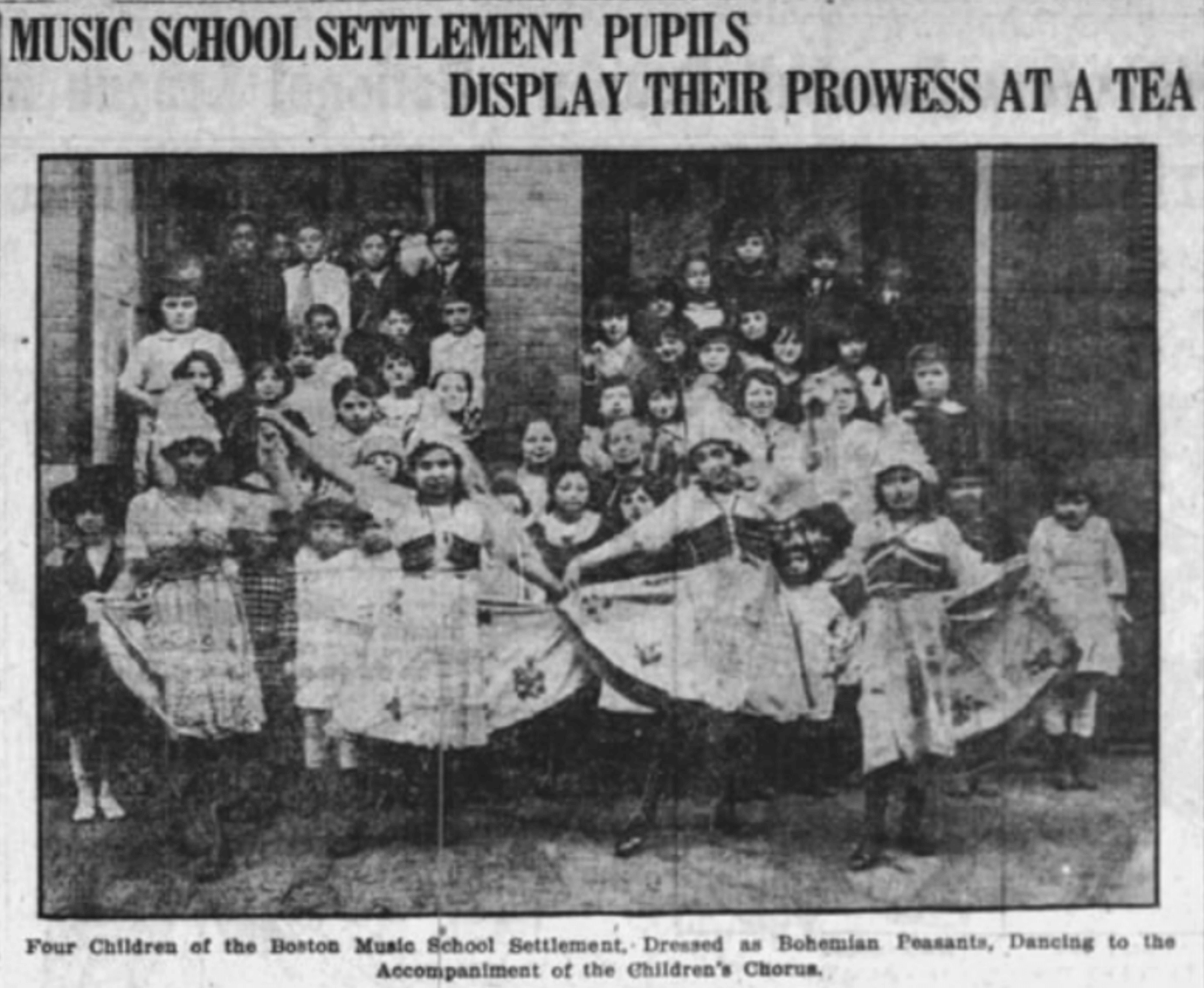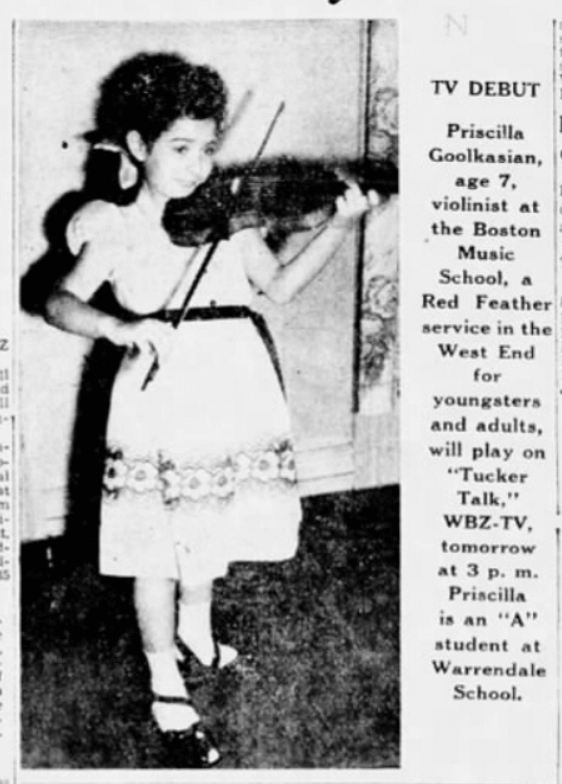The Boston Music School Settlement
Settlement houses were a valuable resource for immigrant families, providing them educational and health services, and practical support in adapting to their new country. Some settlement houses offered specialized services, such as music school settlements, which gave children and adults an opportunity to escape the daily struggles of city life by engaging with the arts.
Boston was fortunate enough to have two music school settlements, the Boston Musical School Settlement and the South End Music School Settlement. The history of the Boston Music School Settlement began in August of 1910, when Daniel Bloomfield, a music teacher at the Civic Service House in the North End, petitioned Boston Mayor John F. Fitzgerald (“Honey Fitz”) to help create a new music school in the neighborhood for poor children. Bloomfield began by teaching piano to students free of charge in a room in the Civic Service House building at 112 Salem Street. The Civic Service House, established in 1901, was a settlement house led by Meyer Bloomfield, and its mission was to “bring out patriotism and intelligence in the North and West Ends.”
Within six months, Bloomfield’s dream took form in 1910, thanks to the support of a band of the city’s leading educators, philanthropists and musicians. Professor Walter Spaulding, Chair of Harvard University’s Music Department, agreed to teach at the school, which would open in its own dedicated building, a former tenement house at 110 Salem Street. Also joining the faculty were renowned international pianist Felix Fox, noted classical composer Arthur Foote, and composer and music historian Winton J. Baltzell. The school’s advisory board included philanthropists Mrs. James J. Storrow (supporter of the West End House), Mrs. Harry E. Converse (wife of the President of Boston Rubber & Shoe Co.), and Mrs. A. Lincoln Filene, who with her husband helped found the Boston Symphony Orchestra.
As reported in the Boston Globe, the goal of the Boston Music School Settlement was “to give children of limited means an opportunity to secure a musical education, to develop the musical resources of the neighborhood and to further health recreation through good music.” The school would offer lessons in “voice, piano, violin, cello and solfeggio [a form of vocal exercise]” to children from 8 to 17, for a nominal fee of 25 cents per lesson. The fee could be waived for those showing an inability to pay. The school also planned to present concerts, lectures and choral classes for adults. On December 15, 1910, pupils from the school, accompanied by singer Bertha Cushing Child and organist Henry L. Gideon, gave their first concert at the North Bennet Street Industrial School hall in the North End.
After its first year, the Boston Music School Settlement was serving 105 students from “Russia, Italy, Portugal, Ireland, England and Sweden”; held concerts; presented a series of “opera talks”; participated in the National Federation of Music School Settlements conference in New York (Bloomfield was later named the organization’s vice president); and organized a Wage Earners Orchestra, comprised mainly of local immigrant workers. Through the generosity of Mrs. Filene and others, scholarships were awarded to the school’s brightest. By 1913, the school had 200 students and “a waiting list almost as equally large,” putting strains on both the school’s financial resources and its physical capacity. Though it was able to continue to operate from Salem Street for the next four years, these constraints eventually forced the Boston Music School Settlement to move to a new location at 41 Allen Street in the West End in the fall of 1917.
Now established in a larger facility in the West End, the Boston Music School Settlement continued to thrive, increasing its enrollment to over 400 pupils by 1920. One report at the time highlighted the settlement’s other function as a center for Americanization, “producing musicians and good American citizens out of a rabble of foreign-born boys and girls.” This, the writer thought, was badly needed in the predominantly immigrant West End. During this period the settlement also expanded into other neighborhoods, running satellite schools in Dorchester and Mattapan.
In 1934, members of the Boston Music School Settlement Corporation voted to rename itself the Boston Music School Inc., noting that the term “settlement” “no longer applied to the work of the school, which is not a charity, but instead a philanthropic educational opportunity.” Shedding its function of helping to assimilate immigrants allowed the former settlement to focus solely on musical instruction. By its 30th anniversary in the 1940s, the school had taught over 10,000 children, many of whom had played with orchestras all over the country.
Before the devastating demolition of the West End, the Boston Music School was forced to relocate from 41 Allen Street when its building was declared unfit to safely house students. After working in temporary locations while in search of a new home, the school finally settled at 283 Commonwealth Avenue in 1955. For thirteen more years, Boston Music School continued to train Boston area youth, before merging, along with the South End Music Settlement, into the Community Music Center in 1968. Today, the Community Music Center of Boston (CMCB) continues the music school settlement legacy set in 1910, transforming “lives by providing equitable access to excellent music education and arts experiences.” CMCB serves as the “largest external provider of arts education to the Boston Public Schools,” providing programs which reach over 3,000 aspiring musicians of all ages each week.
Article by Bob Potenza, edited by Grace Clipson.
Sources: The Boston Globe Oct 27, 1901; Aug 19, 1910; Dec 3, 1910; Dec 14, 1910; May 23, 1911; Sep 11, 1911; Nov 3, 1912; Sep 20, 1913; Oct 20, 1917; Dec 4, 1921; Nov 26, 1924; Dec 2, 1941; Apr 4, 1942; Dec 19, 1942; Jan 20, 1953; Dec 8, 1955; and Aug 14, 1983; J.P. Munroe, New Boston; a chronicle of progress in developing a greater and finer city–under the auspices of the Boston-1915 movement (Boston, 1915); Janet D. Schenck, Music, Youth & Opportunity : A Survey of Settlement and Community Music Schools (Boston: National Federation of Settlements, 1926).


